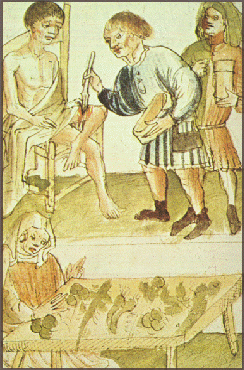
The ointment used on Yvain is a good example of what Medieval medicine was like. It comes from a 'wise-woman', Morgan le Fay, rather than a doctor, and has probably been made from herbs, like most medicine of the time. This is a medieval recipe for an ointment to cure headaches and pains in the joints:

This man's leg wound is being treated, while herbs for a soothing ointment or healing drink are being prepared
Most people in Medieval times never saw a doctor. They were treated by the local wise-woman who was skilled in the use of herbs, or by the priest, or the barber, who pulled out teeth, set broken bones and performed other operations. Their cures were a mixture of superstition (magic stones and charms were very popular), religion (for example driving out evil spirits from people who were mentally ill) and herbal remedies (some of which are still used today). Monks and nuns also ran hospitals in their monasteries, which took in the sick and dying.

Monks weighing out herbs
Morgan le Fay means Morgan the Fairy, and curing people was often connected in people's minds with magic. In a village, the wise-woman (or man) often had knowledge which had been passed on from the generations before, and many years of experience working with herbs. Often, the 'wise-woman' delivered babies too, and her skills were highly valued.
In the earlier part of the Middle Ages, most people accepted magic and witchcraft (good and bad) as part of life. In the 14th and 15th Centuries, however, they were told that witches were servants of the devil. Many 'wise-women' were accused of being witches and put to death.
There were doctors too, of course - although they treated only the rich. Some of these had even received medical qualifications from the first European medical school at Salerno in Italy, or from those set up later at Bologna (Italy) or Montpellier in France. Through these medical schools, the doctors of Europe began to learn about the ideas of Arabic and ancient Greek medicine. Compared to the knowledge of the Arabs, for example, European medicine was not very advanced. A Syrian writer of the time describes how an Arab doctor and a European one argued about how to treat and abscess, an infected lump on a knight's leg. The Arab prepared a dressing with ointment to open the lump and draw out the infection. The European insisted the only thing to do was to cut off the leg!

Doctors giving medicine
Perhaps it is not surprising, then, that even among their rich patients, doctors were not much trusted. Medieval doctors were especially fond of bleeding their patients using leeches, which probably made them even weaker. It is possible that the peasant with his magic stones, herbal drinks and prayers was more likely to recover from his illness than the rich man. Barbers as well as doctors performed all kinds of operations, and in this area of Medieval medicine - surgery - it seems they were rather successful.

Removing an arrow and a lance
Archaeologists looking at skeletons of people who died in the Middle Ages have found that many had broken bones which had healed perfectly. They found evidence to show that although some people had died of sword-wounds, others had wounds which must have been well looked after, since the people did not die until many years later of something completely different.

Archaeologists at a Medieval grave site in London
Doctors and barber-surgeons had plenty of practice treating wounds and broken bones because of the many wars of the time. They knew how to set broken bones in plaster and how to seal wounds using egg whites or old wine to stop them getting infected. They knew how to use alcohol or plants like mandragora to send people to sleep or dull the pain of operations. They could even remove diseased parts of the body, for example the gall-bladder, and deliver babies by Caesarean section (where a cut is made and the baby is taken directly out of the mother's womb).

A woman surgeon performs a Caesarean operation
There were dentists in the Middle Ages too, called dentatores, who had also learnt a great deal from Arab specialists. They had files and forceps and many other tools, and could remove decay, fill holes, strengthen loose teeth with metal wires or even fit false teeth made of ox-bone. Holes were thought to be caused by small worms in the teeth. This isn't very different from the modern idea about bacteria.
Still, only the rich could afford the services of the dentatores. Anyone else with a loose or aching tooth went to have it pulled out at a booth in the fair or market, or by the barber.